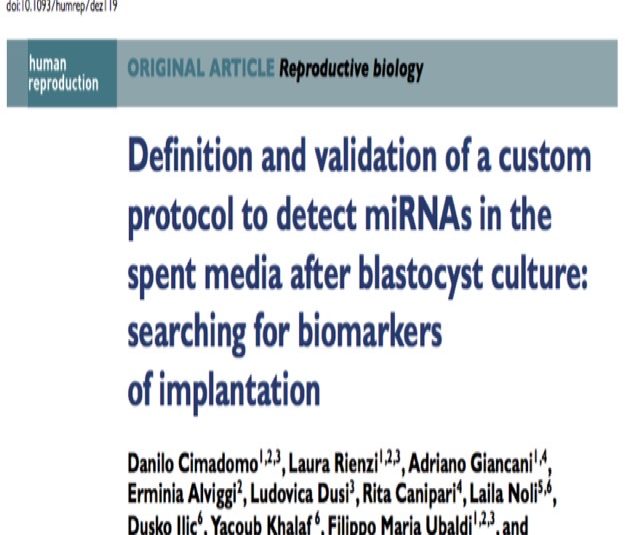
Definition and validation of a custom protocol to detect miRNAs in the spent media after blastocyst culture: searching for biomarkers of implantation
Danilo Cimadomo, Laura Rienzi, Adriano Giancani, Erminia Alviggi, Ludovica Dusi, Rita Canipari, Laila Noli, Dusko Ilic, Yacoub Khalaf, Filippo Maria Ubaldi, and Antonio Capalbo
Human Reproduction, 2019 Aug 16 – pp. 1–16, 2019 doi:10.1093/humrep/dez119
ABSTRACT
STUDY QUESTION: Can miRNAs be reliably detected in the spent blastocyst media (SBM) after IVF as putative biomarkers of the implantation potential of euploid embryos?
SUMMARY ANSWER: Adjustment of the data for blastocyst quality and the day of full-expansion hinders the predictive power of a fast, inexpensive, reproducible and user-friendly protocol based on the detection of 10 selected miRNAs from SBM.
WHAT IS KNOWN ALREADY: Euploidy represents so far the strongest predictor of blastocyst competence. Nevertheless, ∼50% of the euploid blastocysts fail to implant. Several studies across the years have suggested that a dialogue exists between the embryo and the endometrium aimed at the establishment of a pregnancy. MicroRNAs have been proposed as mediators of such a dialogue and investigated in this respect. Several expensive, time-consuming and complex protocols have been adopted and promising results have been produced, but conclusive evidence from large clinical studies is missing.
STUDY DESIGN, SIZE, DURATION: This study was conducted in two phases from September 2015 to December 2017. In Phase 1, the human blastocyst miRNome profile was defined from the inner cell mass (ICM) and the corresponding whole-trophectoderm (TE) of six donated blastocysts. Two di erent protocols were adopted to this end. In parallel, 6 pools of 10 SBM each were run (3 from only implanted euploid blastocysts, IEBs; and 3 from only not-implanted euploid blastocysts, not-IEBs). A fast, inexpensive and user-friendly custom protocol for miRNA SBM profiling was designed. In Phase 2, 239 SBM from IEB and not-IEB were collected at three IVF centres. After 18 SBM from poor-quality blastocysts were excluded from the analysis, data from 107 SBM from not-IEB and 114 from IEB were produced through the previously developed custom protocol and compared. The data were corrected through logistic regressions.
PARTICIPANT/MATERIALS, SETTINGS, METHODS: Donated blastocysts underwent ICM and whole-TE isolation. SBM were collected during IVF cycles characterized by ICSI, blastocyst culture in a continuous media, TE biopsy without zona pellucida opening in Day 3, quantitative PCR (qPCR)-based aneuploidy testing and vitrified-warmed single euploid embryo transfer. Not-IEB and IEB were clustered following a negative pregnancy test and a live birth, respectively. The Taqman Low Density Array (TLDA) cards and the Exiqon microRNA human panel I+II qPCR analysis protocols were adopted to analyse the ICM and whole-TE. The latter was used also for SBM pools. A custom
LIMITATIONS, REASONS FOR CAUTION: This study did not evaluate specifically exosomal miRNAs, thereby reducing the chance of identifying the functional miRNAs. Ex-vivo experiments are required to confirm the role of miRNAs in mediating the dialogue with endometrial cells, and higher throughput technologies need to be further evaluated for miRNA profiling from clinical SBM samples.
WIDER IMPLICATIONS OF THE FINDINGS: Although no clinical predictive power was reported in this study, the absence of invasiveness related with SBM analysis and the evidence that embryonic genetic material can be reliably detected and analysed from SBM make this waste product of IVF an important source for further investigations aimed at improving embryo selection.
STUDY FUNDING/COMPETING INTEREST(S): This project has been financially supported by Merck KgaA (Darmstadt, Germany) with a Grant for Fertility Innovation (GFI) 2015. The authors have no conflict of interest to declare related with this study.
TRIAL REGISTRATION NUMBER: None
Key words: blastocyst / spent culture media / miRNA / embryonic–endometrial dialogue / implantation